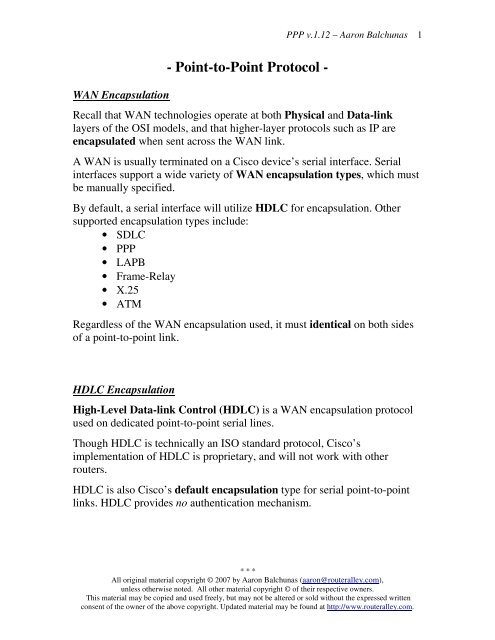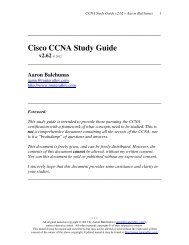PPP - Router Alley
PPP - Router Alley
PPP - Router Alley
Create successful ePaper yourself
Turn your PDF publications into a flip-book with our unique Google optimized e-Paper software.
<strong>PPP</strong> v.1.12 – Aaron Balchunas<br />
1<br />
WAN Encapsulation<br />
- Point-to-Point Protocol -<br />
Recall that WAN technologies operate at both Physical and Data-link<br />
layers of the OSI models, and that higher-layer protocols such as IP are<br />
encapsulated when sent across the WAN link.<br />
A WAN is usually terminated on a Cisco device’s serial interface. Serial<br />
interfaces support a wide variety of WAN encapsulation types, which must<br />
be manually specified.<br />
By default, a serial interface will utilize HDLC for encapsulation. Other<br />
supported encapsulation types include:<br />
• SDLC<br />
• <strong>PPP</strong><br />
• LAPB<br />
• Frame-Relay<br />
• X.25<br />
• ATM<br />
Regardless of the WAN encapsulation used, it must identical on both sides<br />
of a point-to-point link.<br />
HDLC Encapsulation<br />
High-Level Data-link Control (HDLC) is a WAN encapsulation protocol<br />
used on dedicated point-to-point serial lines.<br />
Though HDLC is technically an ISO standard protocol, Cisco’s<br />
implementation of HDLC is proprietary, and will not work with other<br />
routers.<br />
HDLC is also Cisco’s default encapsulation type for serial point-to-point<br />
links. HDLC provides no authentication mechanism.<br />
* * *<br />
All original material copyright © 2007 by Aaron Balchunas (aaron@routeralley.com),<br />
unless otherwise noted. All other material copyright © of their respective owners.<br />
This material may be copied and used freely, but may not be altered or sold without the expressed written<br />
consent of the owner of the above copyright. Updated material may be found at http://www.routeralley.com.
<strong>PPP</strong> v.1.12 – Aaron Balchunas<br />
2<br />
<strong>PPP</strong> Encapsulation<br />
Point-to-Point Protocol (<strong>PPP</strong>) is a standardized WAN encapsulation protocol<br />
that can be used on a wide variety of WAN technologies, including:<br />
• Dedicated point-to-point serial lines<br />
• Asynchronous dial-up links<br />
• ISDN<br />
<strong>PPP</strong> has four components:<br />
• Physical – standard for physical serial communication (such as<br />
EIA/TIA-232-C, V.35, ISDN, etc.).<br />
• HDLC – for encapsulating packets into frames over serial lines.<br />
• LCP – for establishing, maintaining, and terminating point-to-point<br />
links.<br />
• NCP – allows multiple Layer-3 protocols (such as IP and IPX) to be<br />
encapsulated into frames.<br />
<strong>PPP</strong> supports several features that standalone HDLC does not:<br />
• Authentication – secures the communication by forcing the<br />
sending/receiving devices to identify themselves with a username and<br />
password. <strong>PPP</strong> supports two forms of authentication – PAP and<br />
CHAP.<br />
• Compression – improves efficiency on slow links. <strong>PPP</strong> supports two<br />
forms of compression: Stac and Predictor.<br />
• Multilink – allows multiple channels to be bundled or trunked<br />
together to combine the bandwidth. The bundled channels are treated<br />
as one logical channel.<br />
• Callback – provides security and billing services. Allows a client to<br />
first dial a <strong>PPP</strong> server, disconnect, and then have the <strong>PPP</strong> server call<br />
the client back.<br />
• Error Control<br />
* * *<br />
All original material copyright © 2007 by Aaron Balchunas (aaron@routeralley.com),<br />
unless otherwise noted. All other material copyright © of their respective owners.<br />
This material may be copied and used freely, but may not be altered or sold without the expressed written<br />
consent of the owner of the above copyright. Updated material may be found at http://www.routeralley.com.
<strong>PPP</strong> v.1.12 – Aaron Balchunas<br />
3<br />
Configuring Basic <strong>PPP</strong><br />
To configure a serial interface for <strong>PPP</strong> encapsulation:<br />
<strong>Router</strong>(config)# int s0/0<br />
<strong>Router</strong>(config-if)# encapsulation ppp<br />
Recall that <strong>PPP</strong> supports two methods of authentication, PAP and CHAP.<br />
PAP (Password Authentication Protocol) sends passwords in clear text,<br />
and thus does not provide much security. CHAP (Challenge Handshake<br />
Authentication Protocol) uses MD5 to apply an irreversible hash.<br />
To configure <strong>PPP</strong> authentication:<br />
<strong>Router</strong>(config)# hostname <strong>Router</strong>1<br />
<strong>Router</strong>(config)# username <strong>Router</strong>2 password PASSWORD<br />
<strong>Router</strong>(config)# int s0/0<br />
<strong>Router</strong>(config-if)# ppp authentication chap<br />
The first line sets the hostname of the router. The second line sets the<br />
username and password used for <strong>PPP</strong> authentication. The username must be<br />
the hostname of the remote router, and the password must be the same on<br />
both routers.<br />
The above configuration sets the authentication to chap. To instead<br />
configure pap authentication:<br />
<strong>Router</strong>(config)# int s0/0<br />
<strong>Router</strong>(config-if)# ppp authentication pap<br />
To view the encapsulation configured on the interface:<br />
<strong>Router</strong># show interface s0/0<br />
To troubleshoot <strong>PPP</strong> authentication between two routers:<br />
<strong>Router</strong># debug ppp authentication<br />
More advanced <strong>PPP</strong> configuration is discussed in the ISDN guide.<br />
* * *<br />
All original material copyright © 2007 by Aaron Balchunas (aaron@routeralley.com),<br />
unless otherwise noted. All other material copyright © of their respective owners.<br />
This material may be copied and used freely, but may not be altered or sold without the expressed written<br />
consent of the owner of the above copyright. Updated material may be found at http://www.routeralley.com.

















